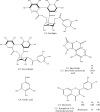In-depth hepatoprotective mechanistic study of Phyllanthus niruri: In vitro and in vivo studies and its chemical characterization
- PMID: 31940365
- PMCID: PMC6961881
- DOI: 10.1371/journal.pone.0226185
In-depth hepatoprotective mechanistic study of Phyllanthus niruri: In vitro and in vivo studies and its chemical characterization
Abstract
Phyllanthus niruri L. is a widespread tropical plant which is used in Ayurvedic system for liver and kidney ailments. The present study aims at specifying the most active hepatoprotective extract of P. niruri and applying a bio-guided protocol to identify the active compounds responsible for this effect. P. niruri aerial parts were extracted separately with water, 50%, 70% and 80% ethanol. The cytoprotective activity of the extracts was evaluated against CCl4-induced hepatotoxicity in clone-9 and Hepg2 cells. Bioassay-guided fractionation of the aqueous extract (AE) was accomplished for the isolation of the active compounds. Antioxidant activity was assessed using DPPH (1, 1-diphenyl-2-picrylhydrazyl) radical scavenging method and ferric reducing antioxidant power (FRAP). The in vivo hepatoprotective activity of AE was evaluated in CCl4-induced hepatotoxicity in rats at different doses after determination of its LD50. Pretreatment of clone-9 and Hepg2 with different concentrations of AE (1, 0.1, 0.01 mg/ml) had significantly reduced the levels of alanine aminotransferase (ALT) and aspartate aminotransferase (AST) against CCl4 injures, and restored the activity of the natural antioxidants; glutathione (GSH) and superoxide dismutase (SOD) towards normalization. Fractionation of AE gave four fractions (I-IV). Fractions I, II, and IV showed a significant in vitro hepatoprotective activity. Purification of I, II and IV yielded seven compounds; corilagin C1, isocorilagin C2, brevifolin C3, quercetin C4, kaempferol rhamnoside C5, gallic acid C6, and brevifolin carboxylic acid C7. Compounds C1, C2, C5, and C7 showed the highest (p< 0.001) hepatoprotective potency, while C3, C4, and C6 exhibited a moderate (p< 0.001) activity. The AE exhibited strong antioxidant DPPH (IC50 11.6 ± 2 μg/ml) and FRAP (79.352 ± 2.88 mM Ferrous equivalents) activity. In vivo administration of AE in rats (25, 50, 100 and 200 mg/kg) caused normalization of AST, ALT, alkaline phosphatase (ALP), lactate dehydrogenase (LDH), total cholesterol (TC), triglycyrides (TG), total bilirubin (TB), glucose, total proteins (TP), urea and creatinine levels which were elevated by CCl4. AE also decreased TNF-α, NF-KB, IL-6, IL-8, IL10 and COX-2 expression, and significantly antagonizes the effect of CCl4 on the antioxidant enzymes SOD, catalase (CAT), glutathione reductase (GR), and glutathione peroxidase (GSP). The histopathological study also supported the hepatoprotective effect of AE. P. niruri isolates exhibited a potent hepatoprotective activity against CCl4-induced hepatotoxicity in clone-9 and Hepg2 cell lines through reduction of lipid peroxidation and maintaining glutathione in its reduced form. This is attributable to their phenolic nature and hence antioxidative potential.
Conflict of interest statement
Natural Wellness Biotech organization provided support in the form of research materials. There are no patents, products in development or marketed products associated with this research to declare. This does not alter our adherence to PLOS ONE policies on sharing data and materials.
Figures




Similar articles
-
Antioxidant and hepatoprotective activity of Fagonia schweinfurthii (Hadidi) Hadidi extract in carbon tetrachloride induced hepatotoxicity in HepG2 cell line and rats.J Ethnopharmacol. 2013 Dec 12;150(3):973-81. doi: 10.1016/j.jep.2013.09.048. Epub 2013 Oct 17. J Ethnopharmacol. 2013. PMID: 24140589
-
In vitro and in vivo antioxidative and hepatoprotective activity of aqueous extract of Cortex Dictamni.World J Gastroenterol. 2017 Apr 28;23(16):2912-2927. doi: 10.3748/wjg.v23.i16.2912. World J Gastroenterol. 2017. PMID: 28522909 Free PMC article.
-
Hepatoprotective activity of flavonoids from Cichorium glandulosum seeds in vitro and in vivo carbon tetrachloride-induced hepatotoxicity.J Ethnopharmacol. 2015 Nov 4;174:355-63. doi: 10.1016/j.jep.2015.08.045. Epub 2015 Aug 29. J Ethnopharmacol. 2015. PMID: 26320690
-
Phytochemical profile and hepatoprotective potentiality of Phyllanthus genus: a review.J Pharm Pharmacol. 2025 Feb 3;77(2):189-205. doi: 10.1093/jpp/rgae040. J Pharm Pharmacol. 2025. PMID: 38642916 Review.
-
Agent in Urgent Need of Clinical Practice: Corilagin.Mini Rev Med Chem. 2023;23(16):1642-1652. doi: 10.2174/1389557523666230112110317. Mini Rev Med Chem. 2023. PMID: 36635908 Review.
Cited by
-
Effects of one-year supplementation with Phyllanthus niruri on fibrosis score and metabolic markers in patients with non-alcoholic fatty liver disease: A randomized, double-blind, placebo-controlled trial.Heliyon. 2023 May 30;9(6):e16652. doi: 10.1016/j.heliyon.2023.e16652. eCollection 2023 Jun. Heliyon. 2023. PMID: 37313177 Free PMC article.
-
The activity of a herbal medicinal product of Phyllanthus niruri and Silybum marianum powdered extracts (Heptex®) in patients with apparent risk factors for nonalcoholic steatohepatitis: a phase II, multicentered, randomized, double-blind, placebo-controlled clinical trial.BMC Complement Med Ther. 2025 Jan 9;25(1):8. doi: 10.1186/s12906-024-04692-y. BMC Complement Med Ther. 2025. PMID: 39789561 Free PMC article. Clinical Trial.
-
Herbal and dietary supplement induced liver injury: Highlights from the recent literature.World J Hepatol. 2021 Sep 27;13(9):1019-1041. doi: 10.4254/wjh.v13.i9.1019. World J Hepatol. 2021. PMID: 34630872 Free PMC article. Review.
-
An insight into the potent medicinal plant Phyllanthus amarus Schum. and Thonn.Nucleus (Calcutta). 2022;65(3):437-472. doi: 10.1007/s13237-022-00409-z. Epub 2022 Nov 12. Nucleus (Calcutta). 2022. PMID: 36407559 Free PMC article. Review.
-
Polyherbal Medicine Divya Sarva-Kalp-Kwath Ameliorates Persistent Carbon Tetrachloride Induced Biochemical and Pathological Liver Impairments in Wistar Rats and in HepG2 Cells.Front Pharmacol. 2020 Mar 25;11:288. doi: 10.3389/fphar.2020.00288. eCollection 2020. Front Pharmacol. 2020. PMID: 32269524 Free PMC article.
References
MeSH terms
Substances
LinkOut - more resources
Full Text Sources
Research Materials
Miscellaneous

